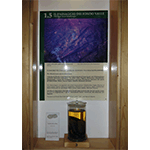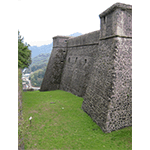Museo di Storia Naturale della Lunigiana [Lunigiana Museum of Natural History]
The Museum, instituted in 1981 at the initiative of the Commune of Aulla, is located in the Brunella Fortress, an imposing structure of Renaissance architecture with square layout built in the first half of the 16th century, probably to the design of Antonio da Sangallo the Elder. It has undergone various restoration initiatives, and was reopened in 1997 by the Natour Cooperative, which has managed it since 1984 and which organises its educational activity.
The exhibition, designed to favour dissemination of the natural sciences and knowledge of the naturalist features of the territory, is made up of three collections: botanical, zoological and mineralogical. The notable botanical collection includes, in addition to the Ferrarini herbarium, compiled by Erminio Ferrarini starting in the 1960s and consisting of a collection of rare plants native to the Apuan Alps, core bores of trunks of various arboreal species and a collection of seeds from local plants. A tree trunk for the study of dendrochronology, a method of dating based on studying the growth rings in trees, is also displayed.
The zoological collection is composed of specimens of fauna from the Lunigiana acquired after the founding of the Museum. It includes stuffed mammals, birds, reptiles and amphibians conserved in fluid, as well as an osteological and an entomological collection, with specimens of butterflies and moths.
The mineralogical collection is made up of rocks, they too collected over the Lunigiana territory, starting from the time when the Museum was inaugurated. The specimens are conserved in the natural state, but there are also some specimens that have been smoothed or worked for educational purposes. Fossil fragments of a mastodon's tusk, coming from the Pontremoli area, are also displayed.
From a suspended garden in the Fortress, scenic panoramas of the Lunigiana territory, the Apennines and the Apuan Alps may be admired.
****************************
Texts by Francesco Marchetti
English translation by Catherine Frost
Last update 16/feb/2008





